That evening, as we dined, overlooking our lovely spot
on the river, we decided to stay yet another day.
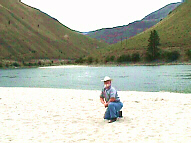 The next morning, we crossed the bridge by our
campsite and worked our way back along the Little
Salmon River, looking for it’s convergence with the
Salmon River. Not far from that point, we found, to
our surprise, a sandy beach on the Salmon River, as
pure and white as any you would find in Hawaii or
Florida. It was quite a contrast with the river and
mountains.
The next morning, we crossed the bridge by our
campsite and worked our way back along the Little
Salmon River, looking for it’s convergence with the
Salmon River. Not far from that point, we found, to
our surprise, a sandy beach on the Salmon River, as
pure and white as any you would find in Hawaii or
Florida. It was quite a contrast with the river and
mountains.
Back to the south of us, we found a salmon hatchery.
Having never seen one, we pulled in to make an
inquiry. The Rapid River Salmon Hatchery, named for
the river it is on, was constructed in 1964 by the
Idaho Power company as part of it’s fish conservation
program. Although it is funded by the
Idaho Power Company it is staffed and operated by the
Idaho Department of fish and Game. The Idaho Power
Company constructed several dams on the surrounding
rivers which has in turn had an adverse impact on the
salmon population.
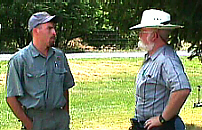 In response to this, hatcheries
and other programs have been instituted in an attempt
to offset the impact. Here we met Zach Olson, who
works for the Department of Fish and Game. Right from
the start, we found him full of energy and a staunch
believer in the roll this operation was playing in
this restocking program. He spent some time taking us
around and explaining each aspect of the program and
how it worked. Each hatchery specializes in a specific
fish. The Rapid River Hatchery specializes in Spring
run Chinook Salmon.
In response to this, hatcheries
and other programs have been instituted in an attempt
to offset the impact. Here we met Zach Olson, who
works for the Department of Fish and Game. Right from
the start, we found him full of energy and a staunch
believer in the roll this operation was playing in
this restocking program. He spent some time taking us
around and explaining each aspect of the program and
how it worked. Each hatchery specializes in a specific
fish. The Rapid River Hatchery specializes in Spring
run Chinook Salmon.
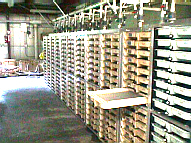 Adult salmon, working their way up the Salmon river
into the Rapid river are trapped by the hatchery.
They are maintained until the eggs of the females are
mature. The male and female fish are separated, the
eggs are removed from the females, fertilized by sperm
from the males, and placed in an incubator, consisting
of a screen, in which fresh water can flow over them.
Three and a half months later they hatch. They will
remain in the incubator for another month or so before
being removed and place in the “raceway”.
Adult salmon, working their way up the Salmon river
into the Rapid river are trapped by the hatchery.
They are maintained until the eggs of the females are
mature. The male and female fish are separated, the
eggs are removed from the females, fertilized by sperm
from the males, and placed in an incubator, consisting
of a screen, in which fresh water can flow over them.
Three and a half months later they hatch. They will
remain in the incubator for another month or so before
being removed and place in the “raceway”.
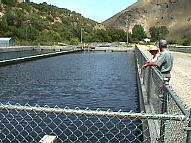 This consists of long narrow waterways where the fish are
trained in basic salmon survival skills. From here
they are put in growing tanks and are fed a high
protein diet. Just before being released back into
the Rapid River, each and every one of them is tagged,
identifying them as having come from this particular
hatchery. Last year, 1200 adult salmon were trapped
producing 3 and ˝ million eggs, with almost 100%
survival rate. That’s a lot of fish to tag, one at a
time. Scores of women were brought in and for weeks
picked up each fish and applied the tag. When finally
released into the river, the salmon will have spent
more then a year at the hatchery.
This consists of long narrow waterways where the fish are
trained in basic salmon survival skills. From here
they are put in growing tanks and are fed a high
protein diet. Just before being released back into
the Rapid River, each and every one of them is tagged,
identifying them as having come from this particular
hatchery. Last year, 1200 adult salmon were trapped
producing 3 and ˝ million eggs, with almost 100%
survival rate. That’s a lot of fish to tag, one at a
time. Scores of women were brought in and for weeks
picked up each fish and applied the tag. When finally
released into the river, the salmon will have spent
more then a year at the hatchery.
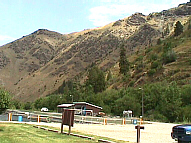 Salmon are anadromous, meaning they undergo a
metamorphous known as smolting. Over about a two week
period, they change from fresh water breathers to salt
water. They must reach the ocean by the end of this
change or die. Once released, the salmon face a
myriad of dangers as they float, backwards, down river
to the ocean facing upstream where they can get the
oxygen and nutrients they need. Those few that make
it, can look forward to a fairly mundane life as they
swim across the Pacific and back over the next two
years.
Salmon are anadromous, meaning they undergo a
metamorphous known as smolting. Over about a two week
period, they change from fresh water breathers to salt
water. They must reach the ocean by the end of this
change or die. Once released, the salmon face a
myriad of dangers as they float, backwards, down river
to the ocean facing upstream where they can get the
oxygen and nutrients they need. Those few that make
it, can look forward to a fairly mundane life as they
swim across the Pacific and back over the next two
years.
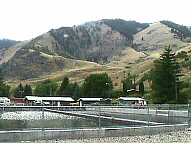 They then start swimming up stream, following, of all
things, the smell of the river water where they were
born, as it mingles with all the other river waters
that run to the ocean. Past the dams, and fishermen,
and Indians with their hoop nets, until they return to
the river at the hatchery. So scarce has natural
spawning become that when fishing for salmon,
excluding those caught by Indians who follow different
rules, a fisherman can keep any salmon which has been
tagged, but if it has no tag, it must be tossed back,
as it is a naturally spawning fish, which is becoming
a rarity.
They then start swimming up stream, following, of all
things, the smell of the river water where they were
born, as it mingles with all the other river waters
that run to the ocean. Past the dams, and fishermen,
and Indians with their hoop nets, until they return to
the river at the hatchery. So scarce has natural
spawning become that when fishing for salmon,
excluding those caught by Indians who follow different
rules, a fisherman can keep any salmon which has been
tagged, but if it has no tag, it must be tossed back,
as it is a naturally spawning fish, which is becoming
a rarity.
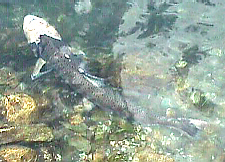 It is recognized that much of the depopulation of the
salmon in this area, can be attributed to the building
of dams along the Snake and Salmon rivers. As we
passed a pen filled with the adult fish Zach pointed
out another problem. He explained that the white on
the salmon’s faces was a nitrogen burn that they
received after reaching a dam. The water, rushing by,
was so laden with nitrogen that it actually cause a
burn on the fish’s face. This condition will continue
to get worse after the fish has passed the dam, and
will finally cause it to die.
We pulled out the next morning heading for Boise,
completely satisfied with our stay in this little
mountain town. Excitement, challenge, knowledge and
beauty. It would be hard to expect more.
It is recognized that much of the depopulation of the
salmon in this area, can be attributed to the building
of dams along the Snake and Salmon rivers. As we
passed a pen filled with the adult fish Zach pointed
out another problem. He explained that the white on
the salmon’s faces was a nitrogen burn that they
received after reaching a dam. The water, rushing by,
was so laden with nitrogen that it actually cause a
burn on the fish’s face. This condition will continue
to get worse after the fish has passed the dam, and
will finally cause it to die.
We pulled out the next morning heading for Boise,
completely satisfied with our stay in this little
mountain town. Excitement, challenge, knowledge and
beauty. It would be hard to expect more.
